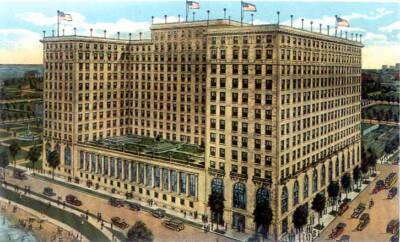The Drake is for sale – the iconic hotel, on the iconic Miracle Mile, is as iconic as deep dish pizza!
So the Drake Hotel is up for sale, is it? Faustian bargains in tiled marble. Ah yes, the iconic Drake Hotel, located on the iconic Miracle Mile, in the heart of the heartland of the tall, bold slugger that we call the Windy City, whose iconic skyline and iconic Lakefront are as iconic as deep dish pizza, not to mention Wrigley Field. I only set foot in the Drake once — to show a friend from Portland, Oregon how the other .00001% live, back in 1998. I figured it was part of the tour, and besides, it satisfied my raging curiosity.

My spouse ate lunch there once, with her mother. They ordered soup — the the only thing on the menu that they (or anyone, aside from Frank Sinatra, who hung out at the Ambassador) could afford. I don’t mean to bad-mouth the dump. It exuded high class. It still does. It opened over a century ago, right after Prohibition began, in 1920. Yet only one major gangster (Frank Nitti) ever lived there for any length of time, and that was well after repeal. Rich socialites used to go there for Afternoon Tea. They still do. There’s harp music in the lobby, for any California Angels who happen to be in the toddlin’ town. Now is that class, or is that crass?
The architecture (Fox & Marshall) is neither spectacular nor offensive — call it tasteful, restrained, or dull, but (unlike, say, Trump Tower) it neither mocks nor obscures anything that surrounds it, be it the iconic John Hancock Center or the once-iconic Playboy Building, (re-)renamed the Palmolive, which was its original name.
The Palmolive, designed by Holabird & Root, is a masterpiece. It opened in 1929, just prior to the Depression. When Chicago native Hugh Hefner bought the joint, he did the unthinkable, putting the once-iconic rabbit ears on the roof. That was in 1965, three years before the Hancock (designed by Fazler Khan, who also did the iconic Sears [now Willis] Tower) debuted. At that point it became obvious even to the most fastidious or naive visitors to the Drake that the Playboy logo was not being used as an aerial antenna, but was, shall we say, ornamental — from an aesthetic standpoint, an earsore. After a quarter-century, Hef, having relocated his empire to the West Coast, sold the building to some developers, who turned it into a condominium, no doubt seeking to restore family values, and the dignity of making a fast buck.
However, in 2003 the ex-Playboy was put on the National Register of Historic Places, which required it to shed its immodesty and assume a modest figure, at least in public. Hence it reverted to its maiden name, in honor both of its commercial origins (Colgate-Palmolive) and to cleanse itself of any unsavory associations with its own past. Having washed its hands off Hefner, it could now resume its place next door to the Drake, without exciting a murmur, let alone a squawk, among the iconic guests who stayed at the iconic chalet in Chitown, secure in their virtue, as well as of those they rubbed up against — everyone else on the Near North Side having been rubbed out, long ago.
When I see the Drake in my mind’s eye, I don’t think of it as just another piece of the vast real estate puzzle, though that’s what it is. Hilton bought it in 1996, which means that Paris and Geneva (respectively) own part of it, but (grande dames that they are) are now bored with it, hence trying to get rid of it. Fickle is as fickle buys and sells. No, I view it as a friend — exactly the advice that Gertrude gave her son with regard to Denmark, the semester he dropped out of Wittenberg College to return to iconic Elsinore Castle. Granted, he didn’t have a mortgage on it, nor did he enjoy the food in the dining room, never mind the after-dinner drinks. But he did have a surreal estate there, just like the iconic celebrities, wanna-be’s, and has-beens who crowd into the lobby, same as me, just to get a glimpse of the great pretenders themselves, in the flash. I coulda been one myself, if fate hadn’t intervened, by denying me the unequal opportunity.
Yet whenever I drive past the Drake on my way downtown, as the lights of the Loop shine down (and off) the Lake, and the S-curve bends around Streeterville, past Oprah’s house (Lake Point Tower), toward Millenium Park and the Wailing Wall, where architects go to mourn the loss of beauty, truth and a feel for nature — a few blocks from Daley Plaza, where the iconic Picasso sculpture protects the Machine from the curse of kitsch, I think of the Roaring ’20s, and how bangs became whimpers — as iconic as the cosmos itself, consumed by the Great Fire in the soft underbelly of the corporate beast. The center did not fold; it folded. Goldbricks of the world unite: you have nothing to lose but your liquidity. Après Le Drake le déluge. Chap. 10, the final audit. Asses to asses: served in an iconic decanter of imported, eco-tourist friendly, Indiana Doom pixie dust, to go.1
1 Denny Jacob, “Chicago’s historic Drake Hotel, which has welcomed guests like Princess Diana and Walt Disney, is for sale.” (Chicago Tribune, August 11, 2021).
- A Shot in the Park: Immunization in Sports - October 13, 2021
- Reuben Klamer and the Death of a Talisman - October 5, 2021
- The Mistake, aka The Drake - August 13, 2021

